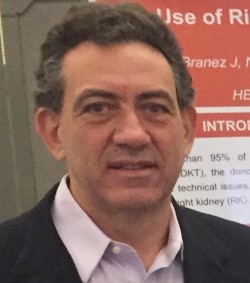
Director of Pancreas and Kidney Transplant Program, Leforte Hospital, Sao Paulo, Brazil
Largest Experience in pancreas transplantation of Latin America with over 1,000 pancreas transplants performed.
Our pancreas transplant program has been one of the most active of the world for the last four years performing from 50-90 PT annualy.
A comparative analysis of IGL-1 versus HTK solution in pancreas transplantation
Marcelo Perosa1, Juan Branez1, Beimar Zeballos1, Leonardo T. Mota1, Fernanda Danziere1, Pedro H. Pereira1, Joise M. Orellana1, Barbara M. Thomaz1, Aline Rocha1, Marcio M. Paredes1.
1Department of Abdominal Organ Transplantation, Leforte Hospital, São Paulo, Brazil
Georges Lopez Institute(IGL-1) is a relatively new preservation solution used for static cold storage of abdominal organs. Although the use of IGL-1 in liver or kidney transplantation is more established, there are limited data regarding its use in pancreas transplantation(PT). The aim of this study was to analyze our experience with IGL-1 in PT.
In a retrospective analysis, data from 186 PT performed from jan/2019 to June/2021, being 121 SPK and 65 solitary PT(S-PT) were reviewed. The use of HTK(n=104) and IGL-1(n=82) solution was stratified into two groups. The profile of donors and recipients, post-transplant(PO) pancreatic enzymes and outcomes were compared.
There were no significant differences between HTK and IGL-1 groups regarding recipient race, age(34.4 x 35.7 years),gender, cerebrovascular cause of donor death(24% x 23.2%), pancreas(8.2 x 8.0h) and kidney(9.5 x 9.3h) cold ischemia time and distribution of SPK/S-PT(59.6%/40.4% x 71.9%/28.1%). Donor age(26.0 x 29.7 years,p=0.002) and use of duodenal drainage(0.96% x 47.6%,p<0.001) were significantly different between HTK and IGL-1 group, respectively. Peak Amylase(379 x 364 UI/ml) and Lipase(364 x 271UI/ml) and PO day 5 Amylase(159 x 148UI/ml) and Lipase(95 x 83UI/ml) were similar between groups. However, peak amylase from drain fluid was higher in HTK group(3869 x 2333 UI/ml, p=0.045). Mean hospital stay(7.8 x 8.0 days), time with abdominal drain(10.5 x 11.4 days) and kidney DGF(45.2% x 52.5%) for SPK were also similar between HTK and IGL-1 groups, respectively. There was a tendency of better 1-year patient survival (89% x 81.7%,p=0.167) and significant higher 1-year pancreas(82.9% x 68.3,p=0.022) and kidney(89.8% x 74.2%,p=0.026) graft survivals for the IGL-1 group. The IGL-1 group was also followed by lower rate of early reoperations (8.5% x 19.2%, p=0.04), technical failure( 7.3% x 17.3%,p=0.047) and death related to technical issues(2.4% x 10.6%, p=0.031).
IGL-1 seems to be superior to HTK solution for pancreas preservation and achieved better outcomes particularly regarding technical issues.